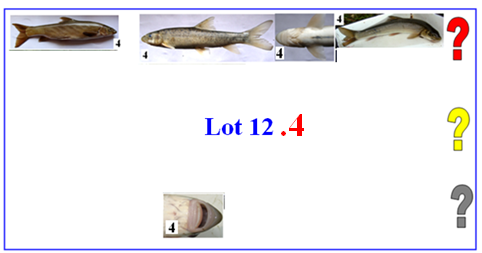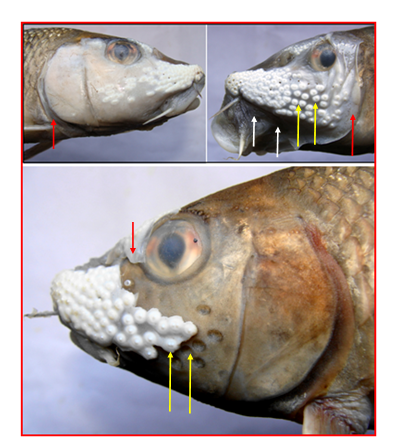SEGREGATION
Lot 12: PART II
[Being more fish samples involved; Segregation of Lot 12, is made available in 2 Parts,
PART I
&
PART II]
A recapitulation from Part I:
The sorting of some fishes in the field was made on the basis of the elongated, cylindrical or compressed body with long caudal peduncle, deeply forked caudal fin, very large (somewhat hexagonal) to small scales, orange or yellowish or pinkish hue on the fins, shining silvery to dull grey-black or brown shades etc.
They were placed under Lot 12, collectively labeled as Minnows or Minor Carps or Mahseers or Suckerfish and numbered 1 to 6 in the assemblage as shown in the photograph below.
The criteria decided in the field for segregation of genera/species represented by the individuals numbered 1 – 6 [in the photograph above] are as shown in the TABLE below:

CLICK HERE TO VIEW LOT – 12: PART I (12.1 to 12.3)
SEGREGATION OF GENUS/SPECIES BASED ON THE CRITERIA DECIDED IN THE FIELD FOR THE SAMPLE INDIVIDUALS
Lot 12: PART – II
No. 12.4 – 12.6.
4
The individuals having smallest scales (among the members of the entire Lot 12) and dark brown or silvery-grey body are found belonging to 2 closely related Genera viz., Schizothorax and Schizothoraichthyes (commonly called Snow Trouts) [Family – Cyprinidae, Subfamily – Barbinae; Minnows or Carps].
Based on the colouration of body the above referred genera are represented by 1 species each, commonly found in the rheophilic environment of Doon valley between 300 – 900m msl.
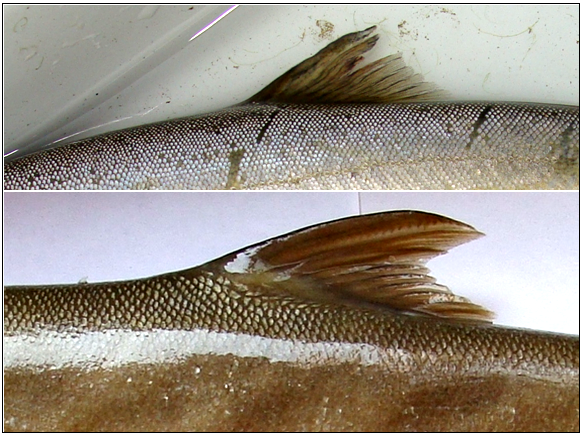
The characterization of each species of Lot 12.4 is as under:
4a
Body elongated, subcylindrical. Dorsal profile arched up to base of dorsal fin. Ventral profile more or less horizontal. Head large with rounded snout (= rostral cap). Mouth inferior, transverse. Lips thick, fleshy. Lower jaw provided with a keratinized cutting edge; a wide continuous labial fold (lower lip) with a parallel running (transverse, strip-like) sucker on the posterior border. Eyes large, not visible from below ventral surface. Barbels 2 pairs, rostral and the maxillary. Dorsal fin undivided ray finely serrated (10 – 12 serrations) at the tip. Scales very small; tile-like at the anal fin base and vent. Body uniformly silvery-grey to steel-grey (the upper part spotted in smaller specimens).
………….. Schizothorax richardsonii
PHOTOGRAPHS OF Schizothorax richardsonii
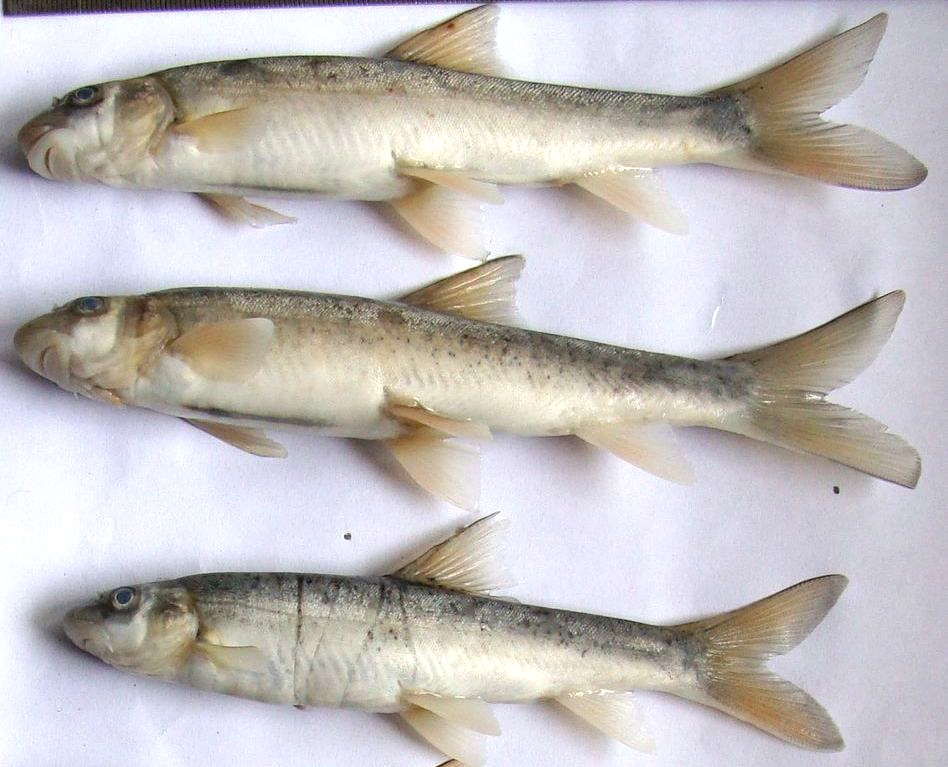
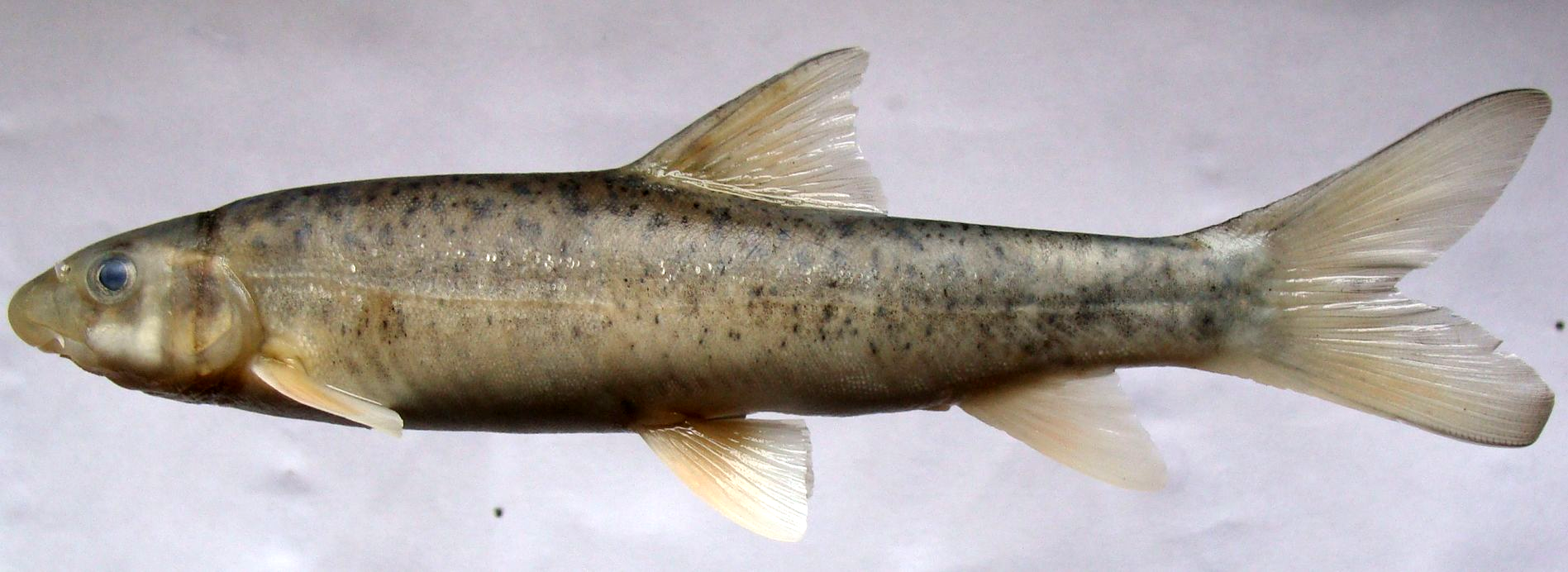
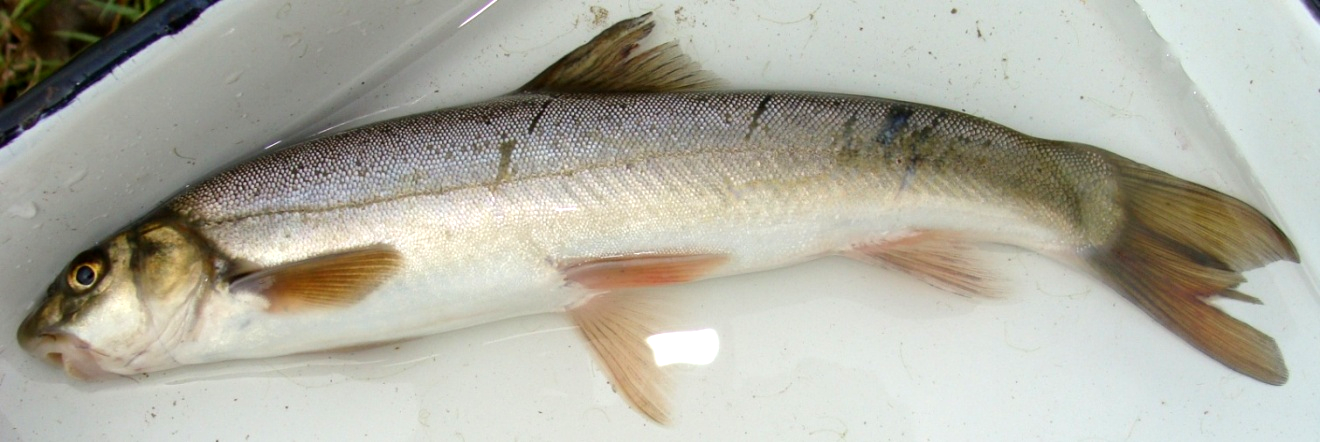
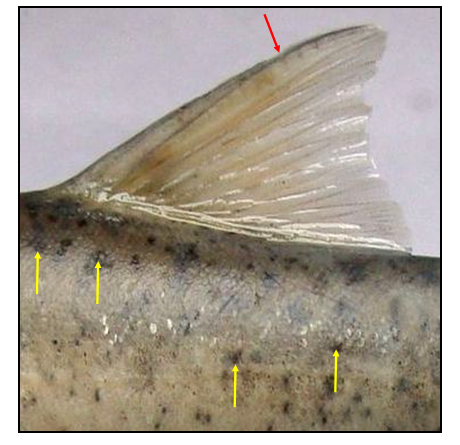
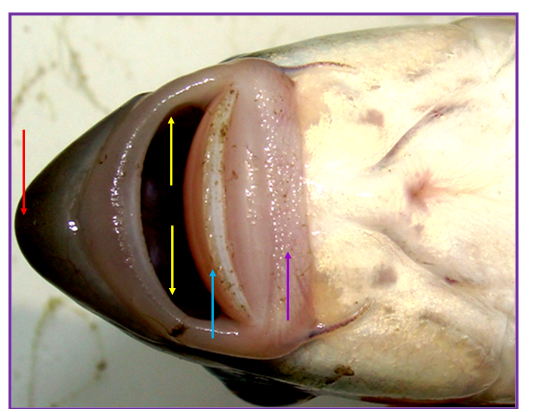
4b
Body elongated, subcylindrical. Dorsal profile arched up to base of dorsal fin. Ventral profile more or less horizontal up to base of anal fin; thence upturned sharply to form straighter ventral face of caudal peduncle. Head large with pointed snout (= rostral cap); studded with warty protuberances below nostrils and between eye and nortils; a few protuberances also present at the lower border of the operculum. Mouth inferior, opening ‘U’-shaped. Lips thick, fleshy; continuous at the angles of mouth. Lower jaw provided with a keratinized cutting edge, lower lip without a sucker. Eyes large, not visible from below ventral surface. Barbels 2 pairs, rostral and the maxillary. Dorsal fin undivided ray finely serrated (about 14 serrations) at the tip. Scales very small; tile-like at the anal fin base and vent. Body uniformly chocolate-brown.
………….. Schizothoraichthys progastus
[= Schizothorax progastus; as per indiabiodiversity.org & www.fishbase.in]
PHOTOGRAPHS OF Schizothoraichthys progastus

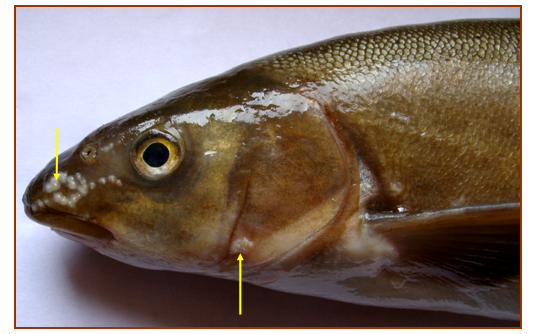
………..Contd.
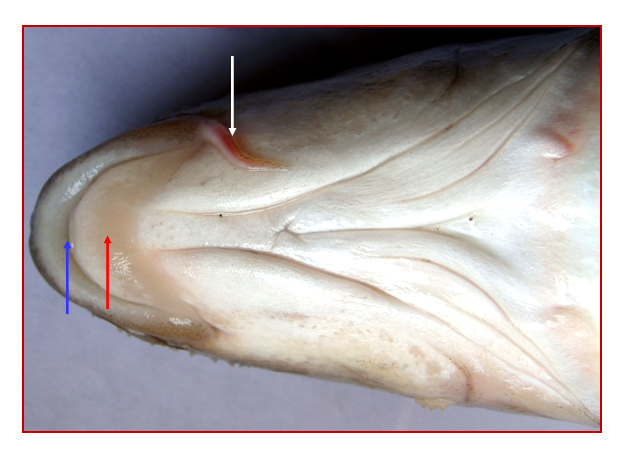
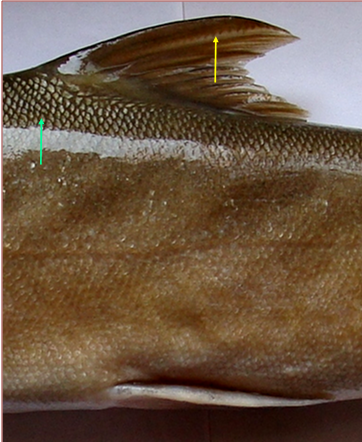
showing finely serrated undivided ray (about 14 serrations) at the tip (yellow arrow) and very small scales (green arrow).
A congregation of swimming young individuals of Schizothorax richardsonii at hilly tract of Baldi River (Sahstradhara, Eastern Doon Valley).
5
The individuals having an adhesive disc on the chin (lower lip) are found to be represented by only 1 Genus and 1 species, Garra gotyla gotyla [Family – Cyprinidae], commonly found in the rheophilic environment of Doon valley between 300 – 900m msl.

The characterization of the species is as under:
5a
Body elongated, compressed at the caudal peduncle. Dorsal and ventral profile equally arched. Head slightly depressed. Snout (= rostral cap) obtusely rounded; with a deep groove across, forming a sort of proboscis; studded with conical (crown-shaped) tubercles. Mouth inferior, cleft semicircular. Lips thick and fleshy; upper lip highly fimbriated (about 14 – 15 fimbriae); lower lip (=labial fold) highly specialized to form a rounded suctorial disc with tuberculations all around the margins. Barbels 2 pairs, one each small rostral and maxillary. Dorsal fin with upper edge sharply curved from the tip of the undivided ray & the Ist divided ray (both the rays being the longest). Pectorals and pelvics spread horizontally. Caudal fin forked; upper lobe being longer. Scales moderate. Dark- greenish-brown along the dorsum; coppery-yellow along flanks and abdomen. Tip of scales edged dark; giving banded appearance along flanks. Fins darkly pigmented with yellowish-red hue.
…………… Garra gotyla gotyla
PHOTOGRAPHS OF Garra gotyla gotyla
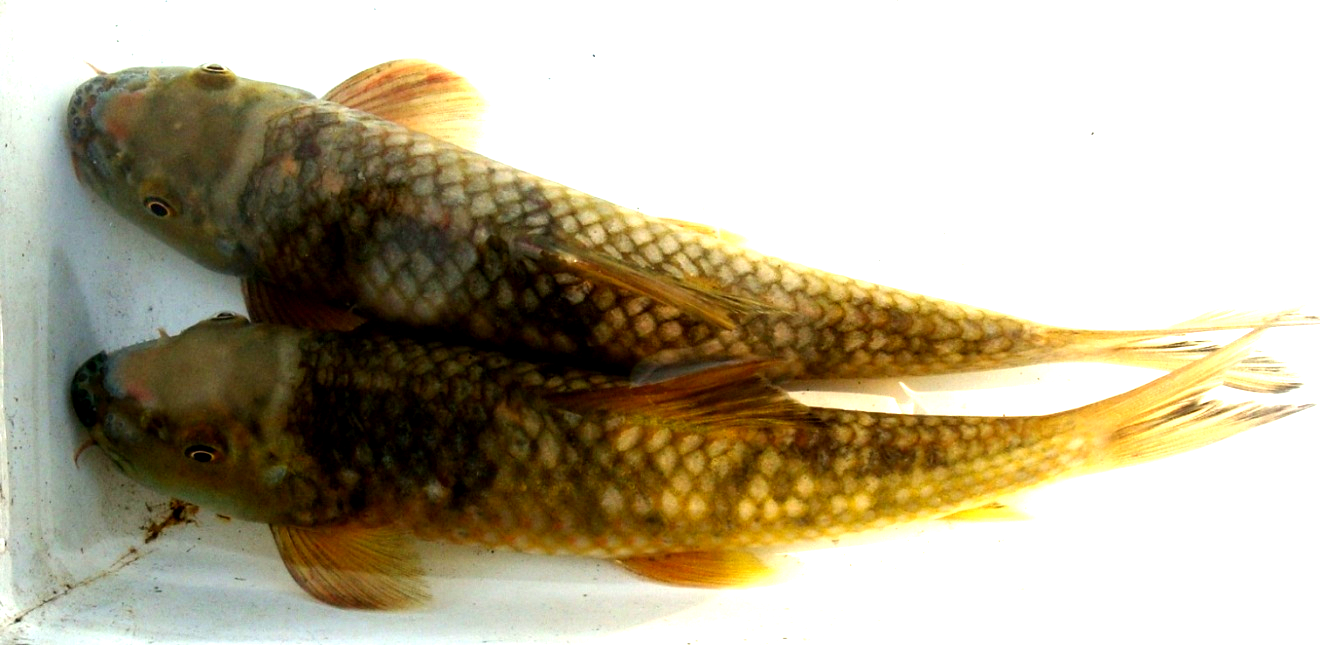
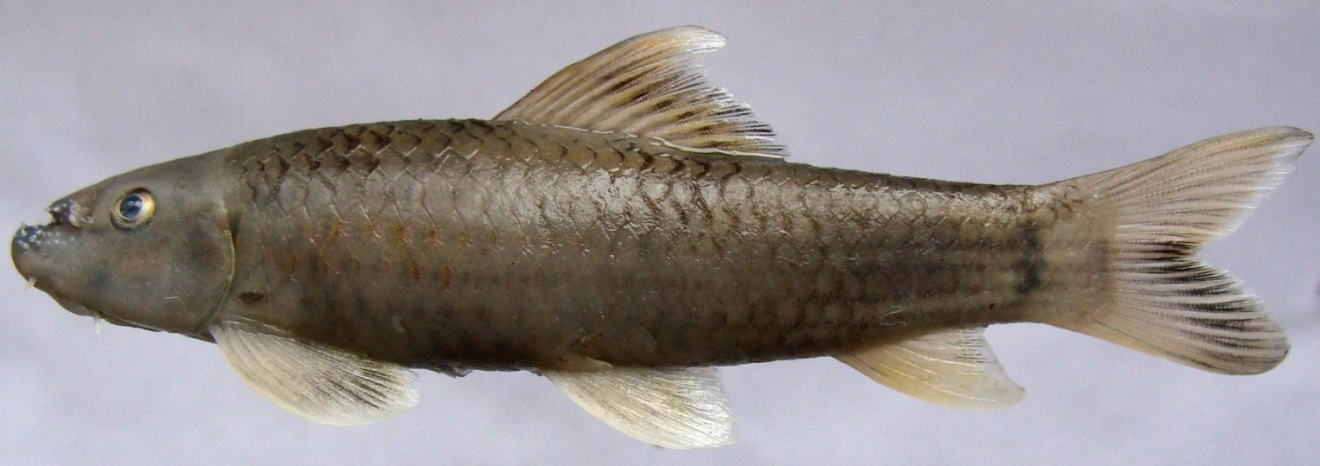
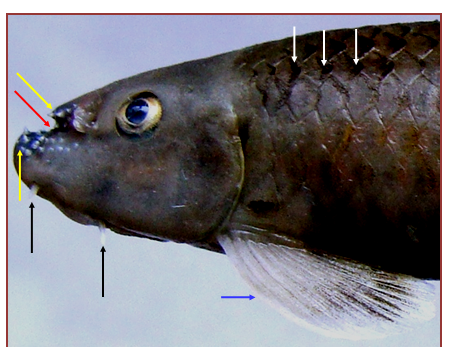
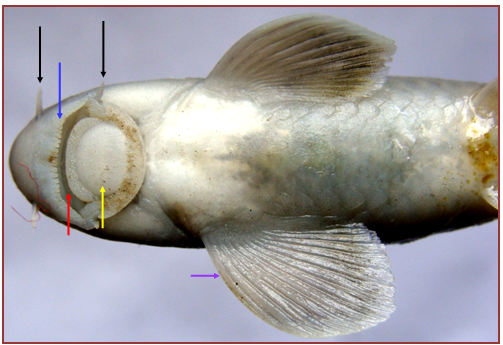
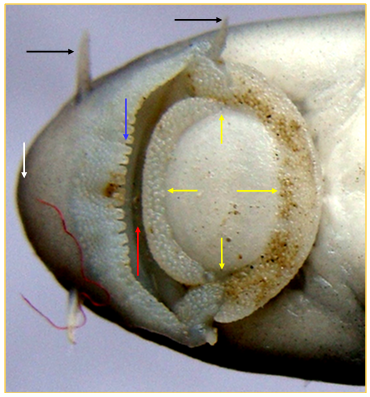
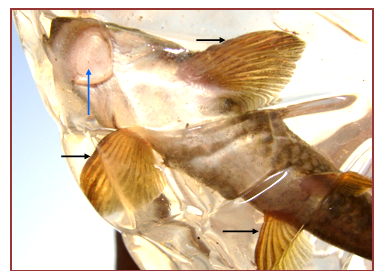
A PLATE VII FROM THE PAGES
OF
‘General and Applied Ichthyology [Fish and Fisheries]’
by SK Gupta.
This PLATE VII refers to CHAPTER – 16 [Study of Fish Fauna], pp 373-469.
The PLATE includes photographs of Raiamas bola (Lot 4) showing a rudimentary maxillary barbel, Crossocheilus latius (Lot-12, PART I, 12.3c) showing upper fimbriated lip and of Garra gotyla gotyla (Lot – 12, PART II, 12.5) showing Sucking disc.

6
The individuals, identified in the field and kept in Lot 12 at No. 6, are found to be diagnostically deep-bodied (amongst the rest 1 to 5), silvery pinkish with moderate-sized scales, each with a dark spot at the base (like Barilius bendelisis, Lot 3) in upper 3/4th of body. Also the inhabitant of rheophilic, clean-watered, deeper environment, this sample is of a curious ‘median Carp’, belonging to Genus Chagunius, with one species Chagunius chagunio [Family – Cyprinidae].
Chagunius chagunio: Silvery pinkish with moderate-sized scales, each with a dark spot at the base (akin to Barilius bendelisis, Lot 3) in upper 3/4th of body.

More sharply exhibiting sex distinguishing characters, it is characterized as under:
6a
Body elongated and compressed laterally. Head conical. Snout bluntly squarish with prominent transverse depression across. Mouth subterminal, ‘U’-shaped. Lips thick, upper one more papillated (in mature males) with fleshy flap on either side; lower lip with a pad on the ventral side with a central depression and striations (a device useful for clinging in rheophilic environment). Barbels 2 pairs, the maxillary longer than the rostral. Undivided ray of the dorsal fin strong and serrated. Uniform bright silvery (more when young) to dull silvery with pinkish hue. Olive-greenish along the dorsum. Each scale with dark spot at the base on upper 3/4th of the body (not prominent in younger specimens); sometimes the dark spots giving the appearance of a dark band along the lateral line. Fins yellowish. Dorsal and caudal suffused with scarlet red and edged black. Pectorals darker to fainter black, intermingled with reddish tinge. Pelvics and anal edged red.
Sexual dimorphism most prominent [see ahead the TABLE, Photographs & research publication].
……….. Chagunius chagunio
PHOTOGRAPHS OF Chagunius chagunio
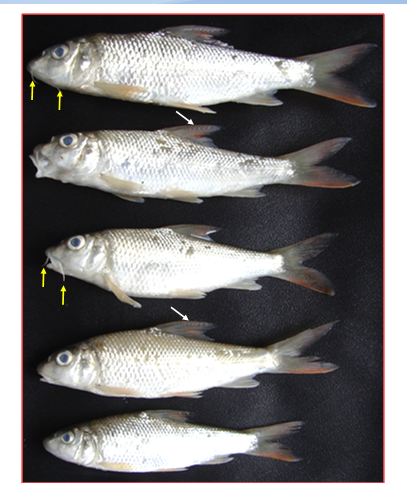
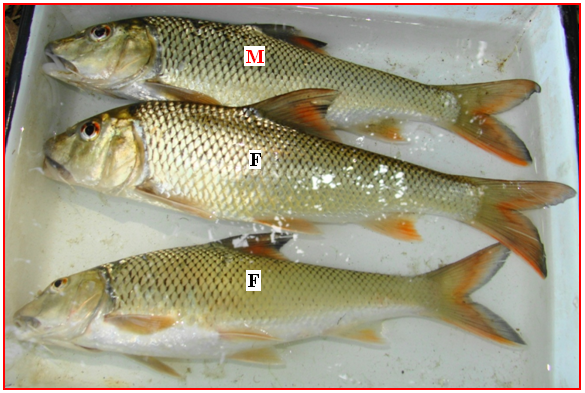
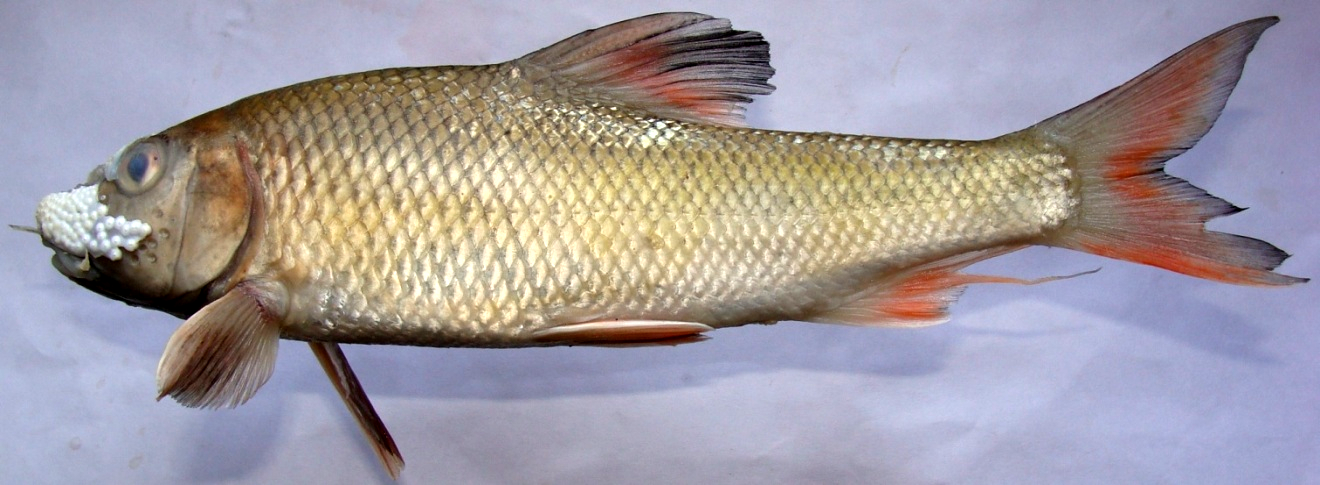
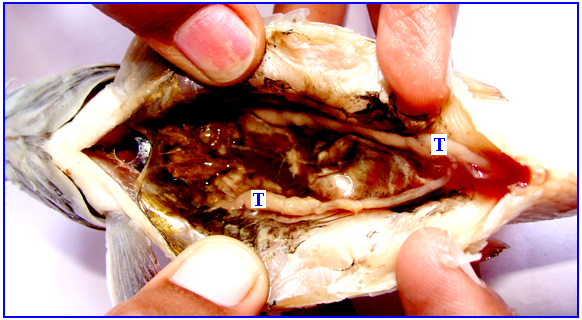

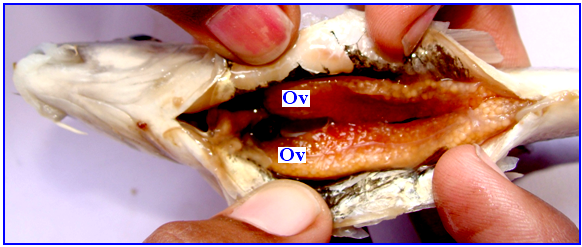
SEXUAL DIMORPHISM IN Chagunius chagunio
The important points of sex distinction in Chagunius chagunio are sorted in the following TABLE:


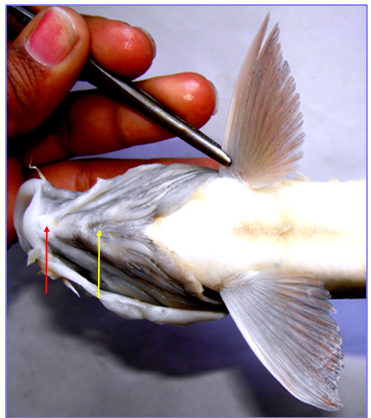
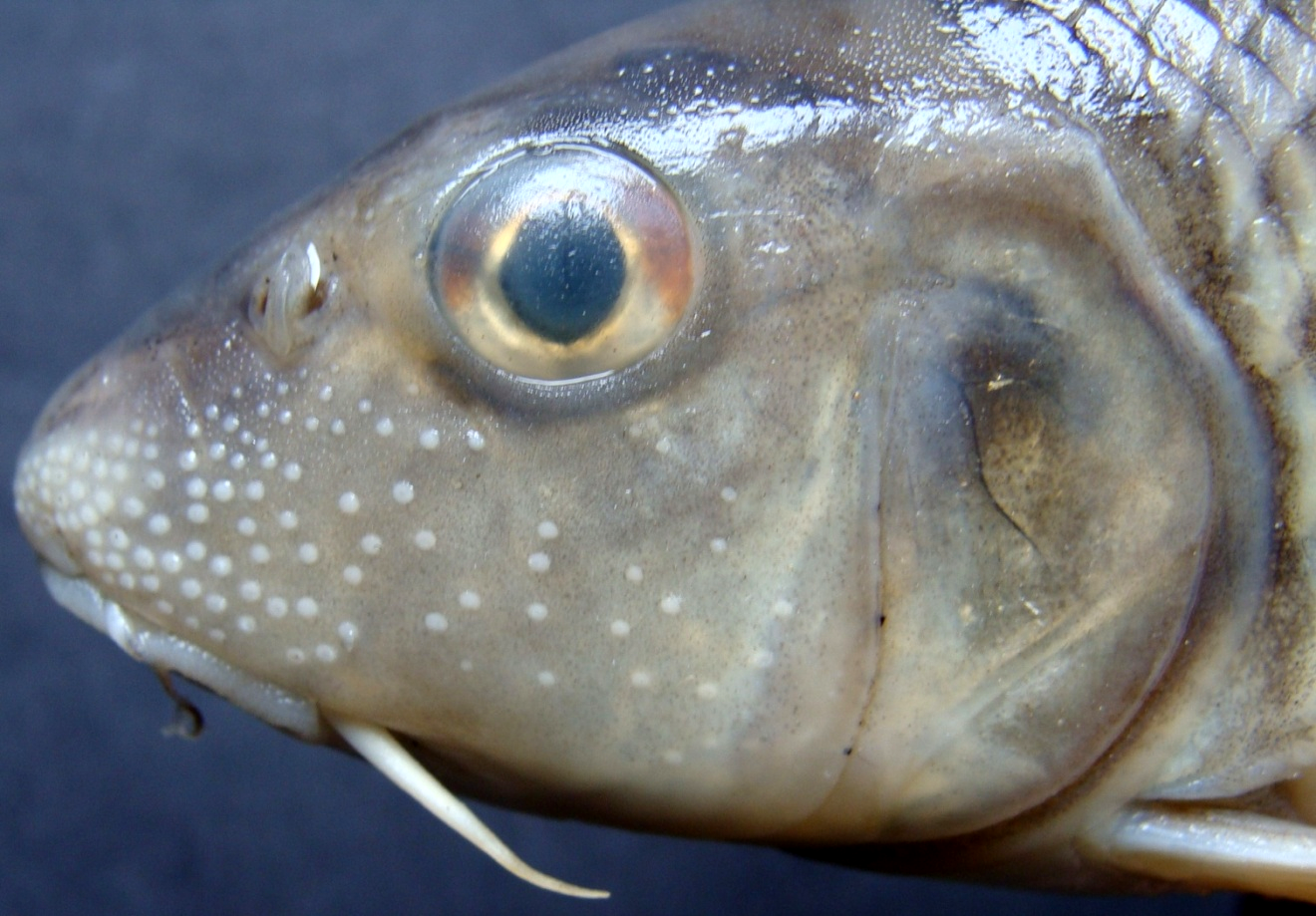
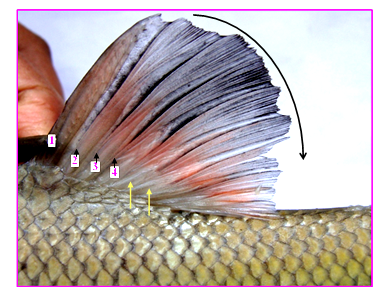
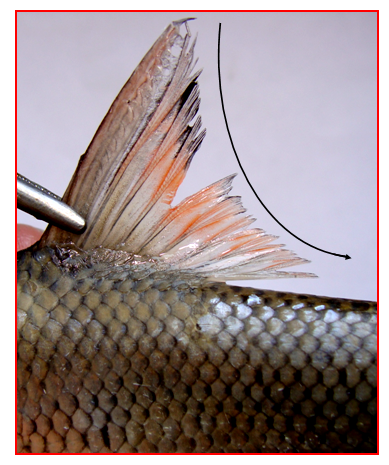
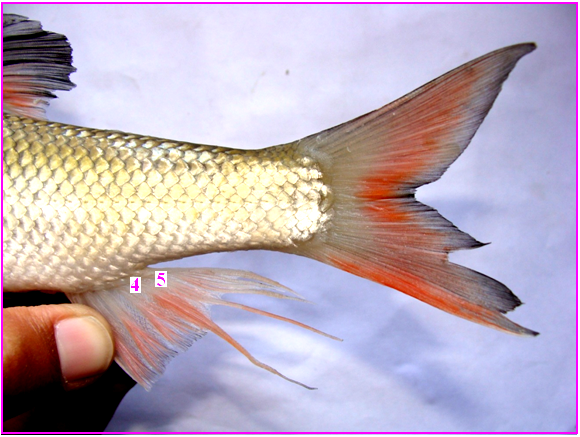
Chagunius chagunio: Anal fin region of female enlarged. Two situations are observed:
1. Majority exhibit normal red-tinged fin.
2. Occasionally, a bit longer but colourless 4th and 5th divided rays.
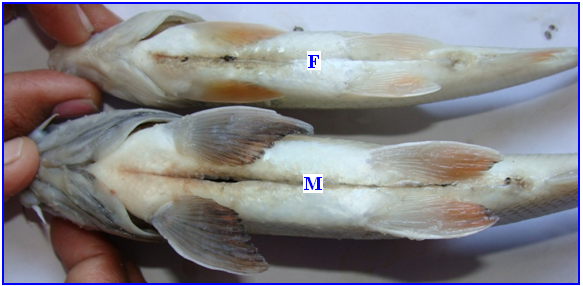
……..View videos next
Observe the male and female live individuals making gentle swimming movements.
Observe the male live individual making gentle swimming movements.












‘Further Taxonomical Notes on Chagunius chagunio (Hamilton) from Doon Valley’, J. Natcon., 21(2): 221-232 (2009)
…….Contd.
Habitat preferances of fishes segregated
out of
Lot 12
PART – I [12.1 – 12.3]
&
PART II [12.4 – 12.6]
Coincidently, habitat-wise, all the samples numbered 1 – 6 are favourite inhabitants of torrential, clear-waters of Eastern [Ganges, Suswa, Song] and Western Doon Valley [Yamuna, Asan and Tons etc]. In deeper waters large-sized individuals are often a common sight.
Tor sp. follow a wide altitudinal range between 300 and 900m msl and are especially favourite for Ganges in Uttarakhand (India) at pilgrimages like Haridwar and Rishikesh (forming temple sanctuaries) and further upstream at higher altitudes like Srinagar, Dev Prayag, Karn Prayag, Tehri etc.
Tor putitora is the dominant species as compared to Tor tor, Tor chelynoides preferring a relatively colder regime above 700m msl, as evidenced by their presence along with the catches of Schizothorax or Schizothoraichthys sp.
Garra gotyla gotyla prefers most turbulent streams, the suctorial disc being advantageous for clinging to stones/rocks. Crossocheilus latius has a habit of venturing over gravel and stony bottom of hilly-streams.
Chagunius chagunio is specially characteristic and abundant in forested tracts of Suswa and Song in the Eastern Doon (more frequent in Suswa stretch) as compared to the Asan river of the Western Doon.
Photographs of habitat preferences by species segregated out of Lot – 12
[PART – I & PART II]





[The samples included in Lot – 4 i.e., Raiamas bola and Barilius telio are also found dwelling comfortabley, here].



 Asan River at Herbertpur (Western Doon): The deeper, stony and pebbly bed, found to be ideal dwelling ground for Labeo and Garra sp.; with occasional catches of Tor putitora.
Asan River at Herbertpur (Western Doon): The deeper, stony and pebbly bed, found to be ideal dwelling ground for Labeo and Garra sp.; with occasional catches of Tor putitora. ……..Contd

A curious sight to observe the poaching activity in the vicinity of Song River
Out of greed and for fulfilling hunting desire for food, man has always been engaged in catching fish indiscriminately or killing them by using various stupefying and illegal methods. Various such methods like hammering, dynamiting, electrocuting or putting fish poisons like bleaching powder or plant poisons viz., Sulla (Euphorbia sp), Khinna (Sapium sp.), Mainu (Randia sp.), Rambans (Agave sp.), Ghass (Polygonum sp.) or Timru (Xanthoxylum sp.) are common in the Garhwal or Kumnaon region of Western Himalayas.
Besides, various active and passive methods are also used locally; the former including stream flow diversion, Jaal, Fatiyala (a triangular net), Karonch (a scoop net), Cloth (dragging device), Kanta (Angling) etc. while the latter including Katori or Channi (a pot-trap), Goda (made of bamboo strips), Parchi (a trap also made of bamboo sticks), Atwal (a kind of drift-net), Faans or Fanda (long nylon twine with loops) etc.
The PHOTOGRAPH below shows illegally hunted large-sized fishes from River Song (Eastern Doon):
The segregation of species out of Lot – 13, belonging to Genus Aspidoparia .
An improvisation and compilation by Dr. S.K. Gupta

